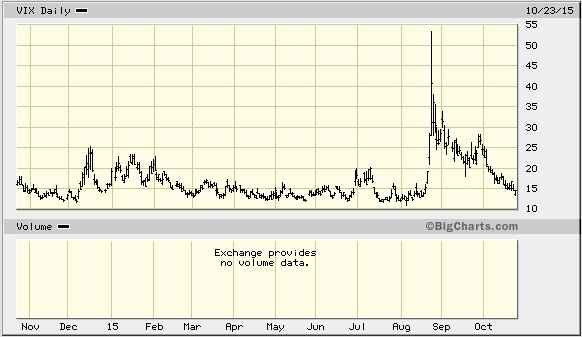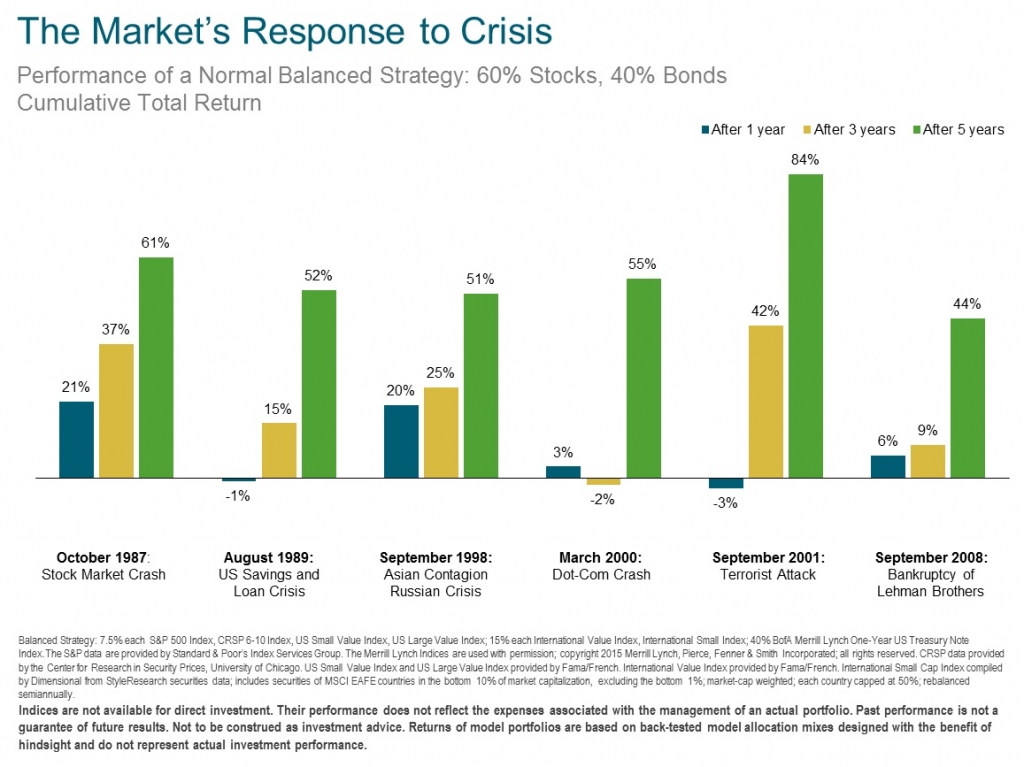”It’s always something. And then it’s nothing.”
Stocks saw their first true panic selling in Third Quarter 2015 since the U.S. default crisis of 2011. In a particularly volatile week in mid-August, the Dow fell nearly 2,000 points in just five trading sessions. The VIX index, which measures the level of fear in the stock market, spiked into the mid-50 range, a level last seen during the 2008-09 financial crisis. For perspective, a reading of 30 in the VIX index is considered “extreme fear.”

Investors responded predictably to these events: They ran screaming for the exits like their hair was on fire. Net equity mutual fund redemptions for the week of August 25 totaled $29 billion – a new record. Net equity fund outflows the day the selling peaked were at a level not seen since October 2008.

Lost in all this hysteria was the reality that a downturn of this magnitude was hardly out of the ordinary. The average peak-to-trough (high point to low point) decline for the market on a yearly basis going back to 1980 is 14.1%. By that measure this decline was little more than business as usual. Yet another $29 billion now sits parked on the sidelines in cash, having missed the upturn that began in September and has continued to the date of this writing.
Where the stock market heads from here is, of course, anyone’s guess. But even if the coming months see another, even deeper, downturn, we know that whatever events are the cause of it – a slowing Chinese economy, rising interest rates, etc. – will eventually run their course. As financial writer Nick Murray is fond of saying, “it’s always something. And then it’s nothing.” Meaning that events resolve themselves over time and then the stock market commences its inexorable upward climb.
Sometimes those events come and go quickly, like the 2011 bear market following the U.S. default crisis. And sometimes those events are long and worrisome, like the 2008-09 financial crisis. Whatever their nature, though, the goal for long-term investors is the same: to be able to endure those events and come out on the other side with your portfolio intact so that you are there when the inevitable recovery commences, as it always does.
That’s why spreading risk among asset classes and investment styles is so important. Many investors who were concentrated in financial stocks were wiped out when The Great Recession hit and had no assets left to invest when the ensuing recovery began in 2009. In contrast, well-diversified investors recovered relatively quickly – as long as they stayed put.
The long recovery that commenced in 2009 was not unusual; in fact, it was typical of market recoveries after major downturns. Consider the chart on the previous page showing the one-, three-, and five-year returns for a hypothetical 60% stock / 40% bond portfolio following some of the major crises of the past thirty years.
Staying put is, of course, the hard part, as evidenced by the billions of dollars that fled the market a few weeks ago. It’s especially hard when the media gloom machine is in full force as it is right now. CNN breathlessly reported on August 26 that “$2.1 trillion was erased from the U.S. stock market in six days.” Who wouldn’t find that alarming? And yet can you recall any article since then pointing out that the market has since added back about $1 trillion? Or pointing out the fact that U.S. household net worth has increased nearly $17 trillion from the pre-recession levels of 2007? Neither can we.
That’s why it’s imperative to turn off the TV and walk away from the computer when panic hits the markets and a long-term perspective becomes difficult to maintain. Just remember this mantra: It’s always something. And then it’s nothing.
Focus on Things You Can Control
When things get dicey in the market and the emotional need to “take action” becomes acute, we always advocate for taking action on the things we can control – as opposed to worrying about the short-term direction of the market, which we can’t control.
In that regard, there are a number of estate planning and asset protection items to remember to help ensure your total financial picture is being addressed, in addition to your investment portfolio. One of the most important areas to consider relates to wealth transfer. Following are a list of items we can help you review and evaluate to be sure your wealth transfer plan is as efficient as possible:
1. Review your existing estate plan. We find the majority of estate plans are not up to date. Why? Life intrudes; things change – your net worth, the tax laws, your family situation, and so on. Be sure your plan is up to date.
2. Create comprehensive financial statements. Be sure you have everything in order. This can be one of the greatest gifts you can give your loved ones in the case of your unexpected death.
3. Define your family goals. What are you looking to achieve? You don’t want your estate planning to be purely tax-motivated; you want it aligned with your values and goals.
4. Consider alternatives for education funding. If funding education is one of your goals, there is a variety of options available to help fund education for future generations while reducing the tax burden on your estate.
5. Consider dynasty or generation-skipping trusts. If there is a desire to pass assets inter-generationally, dynasty trusts can be very helpful in accomplishing this.
6. Evaluate prospects for “opportunity shifting.” Again, there may be opportunities to shift assets and income between different entities or family members that may be very attractive.
7. Review your life insurance planning. Life insurance can be a very effective tool to help ensure that your estate passes to your heirs tax free.
8. Structure a favorable entity package. Setting up the appropriate legal entities is crucial to be sure your wealth transfer goals are optimized, whether those are S corps, LLCs, and others.
9. Determine your charitable goals and gifting alternatives. Your gifting should be structured so that it helps not only your charitable interests but also your estate as well.
10. Prepare the family business for transfer or sale. If you have a family business, you want to really think through – whether you’re planning on selling it now or not – how you are ultimately going to transfer or sell it. There are a number of vehicles available that can create more favorable valuations for transfers between family members.
If we can help you think through how any of these strategies may help you meet your unique values and goals, please do not hesitate to call us so we can add it to the agenda for your next regular progress meeting.
Perspective in Volatile Times
For the first time since 2011, panic selling hit the stock market in August. Small investors fled for the hills as volatility suddenly spiked in the market, selling $29 billion in equity mutual fund holdings for the week of August 25 – a new record.
As of this writing, stocks have enjoyed a significant rebound, but those investors who bailed out weren’t in the market to see the recovery. We fielded several calls from nervous clients during the height of the downturn and were able to calm their fears. As we have said before, the first responsibility of an investment advisor is to be the emotional barrier between the client and their money. In the grand scheme, this role may be more important than any other.
Volatility remains high in the market and may continue to be so in the near term. We offered some perspective on this subject above and hope you will keep these points in mind if volatility continues in the months ahead.
It is in times of turmoil that we have historically seen the largest influx of assets into our program as clients seek the counsel of the advisors they trust. This is a remarkable response and a tribute to the investment strategy that does not focus on the product-oriented offerings of stockbrokers, insurance agents, banks, etc.
Past performance does not guarantee future results. All investments include risk and have the potential for loss as well as gain.
Data sources for returns and standard statistical data are provided by the sources referenced and are based on data obtained from recognized statistical services or other sources we believe to be reliable. However, some or all information has not been verified prior to the analysis, and we do not make any representations as to its accuracy or completeness. Any analysis nonfactual in nature constitutes only current opinions, which are subject to change. Benchmarks or indices are included for information purposes only to reflect the current market environment; no index is a directly tradable investment. There may be instances when consultant opinions regarding any fundamental or quantitative analysis do not agree.
The commentary contained herein has been compiled by W. Reid Culp, III from sources provided by TAGStone Capital, Capital Directions, DFA, Vanguard, Morningstar, as well as commentary provided by Mr. Culp, personally, and information independently obtained by Mr. Culp. The pronoun “we,” as used herein, references collectively the sources noted above.
TAGStone Capital, Inc. provides this update to convey general information about market conditions and not for the purpose of providing investment advice. Investment in any of the companies or sectors mentioned herein may not be appropriate for you. You should consult your advisor from TAGStone for investment advice regarding your own situation.
